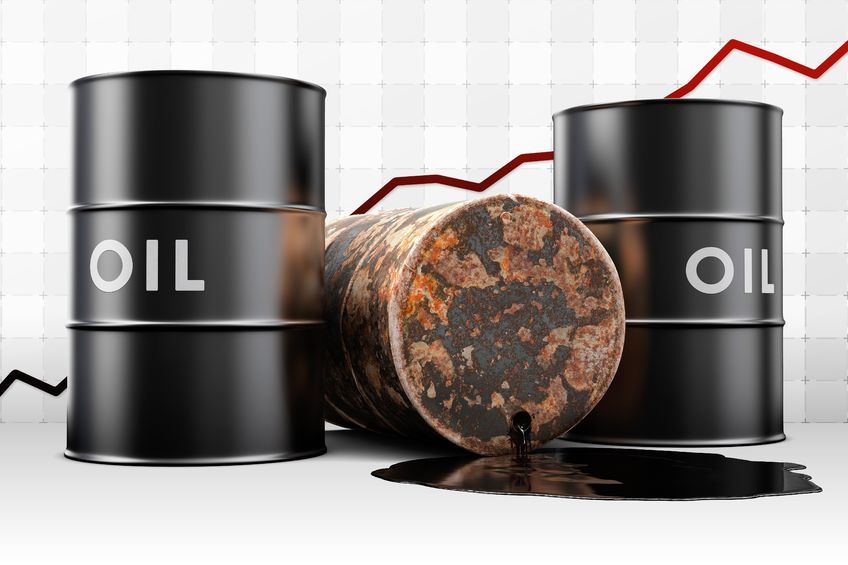Crude Oil
Oil prices settled lower on Monday as rising U.S. output, a weaker physical market and recent dollar strength added to the pressure from a widespread decline across equities and commodities markets. Brent crude futures lost 96 cents to settle at $ 67.63 /bbl. WTI fell by $ 1.30 to close at $64.15 /bbl.
The fall is mainly attributable to a global sell off in equities and commodities. The US Dow Jones Industrial Average as also the S&P 500 had their biggest single day percentage drop since August 2011. The whole picture is confusing and slightly counter intuitive.
Basically, the strong US job numbers, couple with a strong wage raise indicate a robustly growing economy. This suggests the onset of inflation. Now the fear is that, in order to counter the anticipated inflation, the Federal Reserve may hike interest rates. This makes money more expensive, hence the profit booking in markets in general.
Now the panic having set in, people run to the US Dollar as a safe haven currency. Therefore the dollar strengthens. This makes commodities more expensive to buy, hence oil futures get sold off.
This sale would be more in the nature of profit booking than any bearishness seen in the broad oil markets.

In terms of futures direction, we are forced to look at technicals in the absence of any significant fundamental change. The first significant change is that Brent has closed outside a rising channel on the downside for the first time in two months and only the second time in the last six. A two day close outside the channel may signify the change in uptrend. A candle stick pattern of ‘Falling Three Methods has been made which signifies a continuation of the bearish trend. The immediate support is at the 50 DMA (which appears on the scene after a long time at $ 66.57 and then $ 66.05 levels after that.
In other news Exxon Mobil Corp said on Friday that it expects global oil demand to drop sharply by 2040 if there is full implementation of regulations aimed at limiting the impact of greenhouse gas emissions on climate. Under this scenario, Exxon projected world oil consumption will drop 0.4 percent a year to 2040, to about 78 million barrels per day (bpd). That is about 25 percent below current levels, which the U.S. Energy Information Administration puts at 98 million bpd.
Naphtha
Asia’s naphtha crack fell to a three-session low of $74.45 /MT today as buyers appeared to have completed their term purchases.
The balance February paper naphtha crack has weakened to -$ 0.35 /bbl today.
Gasoline
The Asian gasoline crack also eased by 2.8 percent to $ 9.6 /bbl. The average Gasoline Brent crack for January settled at $ 7.73 /bbl, the lowest seen for any January since 2015.
The balance February paper 92 Ron gasoline crack has further eased to $ 12.20 /bbl.
Hedging recommendation made earlier are being retained (until they are squared off). Current values are juxtaposed in (Red)
March 2018 $ 13.35 / bbl (12.75 currently).
Distillates
The Asian Jet fuel crack to Brent eased slightly from a more than 2 year high achieved on Friday. The jet fuel market complex has been boosted in recent weeks by a surge in demand and tight prompt availability. However, bullish sentiment in other areas of the jet fuel market helped to boost the prompt-month jet fuel time spread to fresh highs at a premium of $1 a barrel during Asia trade on Monday, its biggest premium in more than four years.
Meanwhile, the front-month 500ppm gasoil crack fell to a near-two-week low, slipping further away from the more than two-year high of a week ago. The weaker front-month margins for middle distillate fuels came despite weaker crude oil prices.
The balance February paper gasoil crack is slightly lower at $ 15.35 /bbl. The 10 ppm crack is at $ 16.20 /bbl. The February regrade continues to post gains and is valued at $ 1.40 /bbl today.
Hedging recommendations made earlier are being retained (until they are squared off). Current values are juxtaposed in (Red)
February 2018 Gasoil 10 ppm $ 16.15/bbl (15.90) : Jet $ 15.50/bbl (16.60)
4Q 2018 Gasoil 500 ppm $ 15.35 /bbl (14.85): Gasoil 10 ppm $ 16.20 /bbl (15.85): Jet $ 16.00 /bbl (15.75).
1Q 2019 Gasoil 500 ppm $ 15.85 /bbl (15.15) : Gasoil 10 ppm $ 16.80 /bbl (16.10): Jet $ 16.55 /bbl (15.90)
We would also recommend hedging Cal 2019 (for aggressive hedgers) at
Cal 2019 Gasoil 500 ppm $ 16.10 /bbl (16.05): Gasoil 10 ppm $ 17.45 /bbl (17.00): Jet $ 16.85 /bbl (16.80)
Fuel Oil
Asia’s fuel oil markets kicked off the week on a muted note with limited trade activity in both the physical and derivatives markets. Expectations of further weakness in crude oil prices likely kept buyers on the sidelines on Monday. Meanwhile, selling pressure weighed on the near-dated 180-cst fuel oil structure as the front-month time spread of the fuel flipped to contango for the first time since Jan. 22 amid limited demand for the fuel.
The February 180 cst crack is however valued much higher at -$ 4.70 /bbl. This seems to be more because of falling crude prices. The visco spread is unchanged at $ 0.80 / bbl.
About this blog
This blog post attempts to give a top level summary of the Singapore market goings on to a person who seeks to obtain a directional sense of the market on a daily basis.
Disclaimer : All the views are the author’s personal views. These do not constitute an advice to buy or sell any commodity
